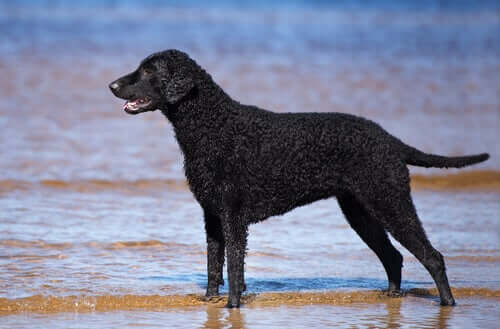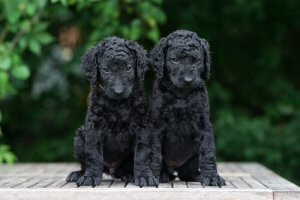Discover the Curly-Coated Retriever

The Curly-Coated Retriever is one of the most iconic English hunting dogs. Athletic, active and versatile, these dogs make the perfect hunting partners, as well as great family pets. These are just some of the characteristics that define the Curly-Coated Retriever.
English retrievers became very popular in the 1800s. Today, they’re fairly rare, and one of the few officially classified as a native English breed. Their rarity and unusual coat have won them great popularity in recent years, especially in Europe.
In this article, we’ll take a look at some of the characteristics and peculiarities of the Curly-Coated Retriever.
The Curly-Coated Retriever – physical characteristics
The Curly-Coated Retriever’s most notable characteristic is its fur, which is made up of small, tight curls. The males measure a maximum of 27 inches in height, while females measure around 24 inches. Their long legs and strong physique mean they’re classified as a large breed.
Pedigree Curly-Coated Retrievers may have solid black or solid liver-colored fur. Another notable characteristic is their firm, muscly chest, and their large eyes.
But for those who are thinking about adopting one of these dogs, there are more important things to take into account than their physical appearance. Energy, temperament and health are essential aspects to keep in mind if you want to give these dogs a good quality of life.
A physically active yet docile breed
This type of retriever is characterized by being highly energetic, which means they need to do large amounts of physical activity. As a result, they can be used as either a hunting dog or a family pet. Owners should be prepared to meet these physical needs.
From a behavioral point of view, the “curly” is an obedient, docile breed that’s happy to obey commands. Their history as hunting dogs and retrievers means they can be a little mistrustful toward strangers.
Ideally, they need to live in a house with a large patio, and go out for long walks every day. They adapt best to young, active families. Making sure to keep them physically active as this will increase their life expectancy, which is approximately 10 – 11 years on average.
Diet and coat
In England, this breed is usually fed a mixture of meat and vegetables. Their high level of physical activity means they have fairly demanding dietary requirements. Standard dog food won’t be enough, and is often used as a supplement instead.
As for their coat, it’s important to remember to brush them at least twice a week. They don’t need particularly special care, and will only need the occasional bath.
The most important thing is to remove any dead hair, brushing in a circular motion. That way, you can help to shape their characteristic curls. You’ll also need to check their skin regularly for ticks.
However, you’ll need to do plenty of work to train and socialize these dogs:
The Curly-Coated Retriever: an intelligent breed
Curly-Coated Retrievers are highly intelligent dogs. They’re ranked No. 41 out of 131 in the Stanley Coren list of smartest dogs. However, training these dogs can be a challenge for a number of reasons, such as their character.

Their great energy poses a huge challenge when it comes to training Curly-Coated Retrievers. They quickly get bored of repetitive, monotonous training routines, so it’s important to make sure you include plenty of variety, and be patient.
In light of all this, experts recommended socializing these dogs from as early as three months old. As they get older, they will develop strong habits and personality traits which are difficult to unlearn.
Health and medical issues
Curlies are generally fairly healthy animals. However, there are three diseases that are common in this breed. The first is hip dysplasia, a condition caused by their particular morphology and high activity levels.
Secondly, it’s important to be aware that these dogs are prone to developing epilepsy. And finally, you’ll need to keep an eye out for ticks and diseases associated with this small arachnid.
Last but not least, according to a survey carried out in England in 2004, the most common cause of death among Curly-Coated Retrievers was cancer, which was responsible for 30% of deaths. Natural death and diseases of the digestive system came in second place, while heart disease made up 5% of deaths. With that in mind, it’s even more important to ensure these dogs stay active, in order to help promote a strong cardiovascular system.
